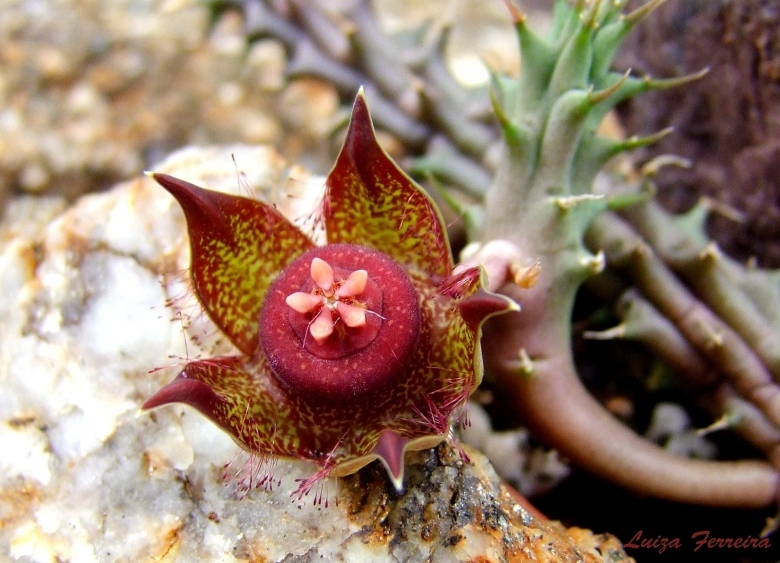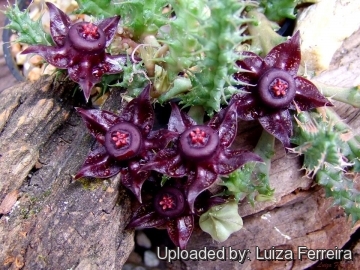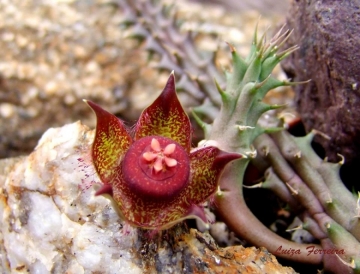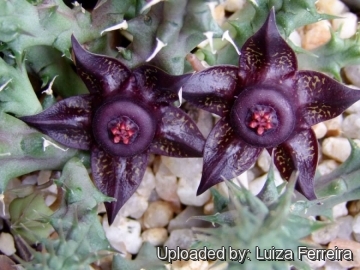
Duvalia polita Photo by: Luiza Ferreira
Origin and Habitat: Duvalia politaSN|30450]]SN|30450]] is locally frequent in Angola, Botswana, Namibia, Mozambique, Zambia, Malawi, Zimbabwe and South Africa (Gauteng, KwaZulu-Natal, Limpopo, Mpumalanga, Northern Cape, North West).
Habitat and ecology: This species is widely distributed in dry savannah regions where it form clumps among Mopane (Colophospermum mopane) or Acacia woodland and scrub in sandy soils.
Altitude range: 1000 - 1600 metres above sea level.
Synonyms:
See all synonyms of Duvalia polita
back
Accepted name in llifle Database:Duvalia polita N.E.Br.Gard. Chron. n.s., 1876(2): 130 1876Synonymy: 7
back
Common Names include:
ENGLISH: Polished star, Polished Duvalia
Description: Duvalia politaSN|30450]]SN|30450]], commonly known as the 'polished duvalia' or the 'polished star' is a fleshy-stemmed, perennial succulent member of the Asclepiadaceae family that with this morphology form a group collectively known as the stapeliads. The polished star is a small species rarely exceeding 10 cm in height. The flowers appears in clusters of 3-4 on the young stems and are up to 3.8 cm in diameter, rich purplish-chocolates, with a lighter annulus mottled with cream, the lobes are smooth and shiny in the basal half, with club-shaped hairs at the base between lobes. D. polita is also easily recognizable vegetatively on account of its large leaf rudiments and the strong tendency to produce rhizomes. The species is variable but does not warrant infraspecific taxa.
Derivation of specific name: “polita”: polished, referring to the smooth and shiny appearance of the base of the corolla lobes.
Stems: Rhizomatous, branched, rather elongated or cylindrical, lax, decumbent, or erect, obtusely 6-angled, green often mottled brown, measuring 2-10 cm above ground (or sometime more under cultivation) about 7-15 mm thick with subulate-pointed teeth 5-8 mm long. Below ground stems 1-10 cm long, 5-8 mm in diameter, cylindrical to pencil-like, ivory.
Leaves: Fleshy, spine-like rudimentary, acute, up to 6 mm long, quickly drying out and wearing off; stipular denticles (glands) well developed ± 0.5 mm, oblong.
Flowers: 3–4 together, procumbent, from the basal stem parts on the young stems, successively developed. Pedicels about 15-25 mm long, rather slender, purplish. Sepals about 4-6 mm long, lanceolate-subulate, dingy green. Corolla 20-38 mm across, dull green on the back, maroon to very dark reddish-brown or rich purplish-chocolate, or yellowish-green spotted this way on yellowish-green ground on the inner face, very smooth and with a high gloss on the basal 2/3 of the lobes, not shining elsewhere. Corolla-lobes erectly spreading, rising with tips higher than the annulus, 8-15 mm long and 7-10 mm broad, ovate, acuminate, with the sides but slightly folded back, glabrous on both sides, ciliate on the basal half with very long vibratile clavate purple hairs 0.5 -2.5 mm long. Annulus about 8-12 mm diameter, 0,2 to 5 mm high, circular to pentagonal, spotted or unspotted, margin with smooth transition to the Cl lobes, upper rim minutely puberulous. The inner and outer corona lobes surround the gynostegium (the collective term for the staminal column and style head). Outer corona 5 mm in diameter, pentagonal, chocolate-red; inner corona-lobes dull orange-red. Within the gynostegium are two carpels, each with unilocular ovaries but with one common style. The five guide rails are the receptive structures for the pollen and are distributed around the style head. The pollen is massed in pollinia, which join to form pollinaria. Five of these also surround the style head. This deceivingly complex flowers attract flies as pollinators (a carrion scent is given off by the corolla lobes and annulus). Pollinia 0.4 x 0.27 mm.
Flowering time (in habitat): Jan – Mar.
Fruits: Flies pollinated, the flowers resulting in the typical twin seed horns (follicles), which are to 20 cm long, decorative in themselves and often don't appear until a year later.
Seeds. 5-7.5 x 4-5 mm.
Bibliography: Major references and further lectures:
1) N. E. Brown. “Flora Capensis”, Vol 4, 1909
2) Foden, W. & Potter, L. 2005. Duvalia polita N.E.Br. National Assessment: Red List of South African Plants version 2014.1. Accessed on 2015/02/09
3) Bruyns, P.V. (2005). "Stapeliads of Southern Africa and Madagascar" Volume I Umdaus Press, Hatfield, South Africa Pages 71 - 73.
4) Focke Albers, Ulrich Meve “Illustrated Handbook of Succulent Plants: Asclepiadaceae: Asclepiadaceae” Volume 4 Springer, 2002
5) Kirby, G. (2013). "Wild Flowers of Southeast Botswana" Struik Nature, Cape Town South Africa Page 369. as: duvalia polita
6) Mapaura, A. & Timberlake, J. (eds) (2004). "A checklist of Zimbabwean vascular plants Southern African Botanical Diversity Network Report No. 33" Sabonet, Pretoria and Harare Page 20.
7) Phiri, P.S.M. (2005). "A Checklist of Zambian Vascular Plants Southern African Botanical Diversity Network Report No. 32" Page 25.
8) Plowes, D.C.H. (1971). "Stapeliads in Rhodesia" Excelsa 1 Page 17.
9) Ethnobotany of the Kwanyama Ovambos : 51 (1985).
10) List South. African Succ. Pl. : 25 (1997).
11) Hyde, M.A., Wursten, B.T., Ballings, P. & Coates Palgrave, M. (2015). "Flora of Zimbabwe: Species information: Duvalia polita var. polita."
http://www.zimbabweflora.co.zw/speciesdata/species.php?species_id=146590, retrieved 9 February 2015
 Duvalia polita Photo by: Luiza Ferreira
Duvalia polita Photo by: Luiza Ferreira Duvalia polita Photo by: Luiza Ferreira
Duvalia polita Photo by: Luiza Ferreira Duvalia polita Photo by: Luiza Ferreira
Duvalia polita Photo by: Luiza FerreiraSend a photo of this plant.The gallery now contains thousands of pictures, however it is possible to do even more. We are, of course, seeking photos of species not yet shown in the gallery but not only that, we are also looking for better pictures than those already present.
Read More... Cultivation and Propagation: Duvalia politaSN|30450]]SN|30450]] is a tiny, but easy obliging blooming plant when mature, that it is happy in any average succulent house. This species favours more humid conditions than other duvalias.
Potting: Since roots are quite shallow, use a soft and incoherent cactus mix or add extra perlite or pumice to regular soil potting soil, and clay pots help the plants to dry out between watering.
Waterings: Duvalia require moderately watering through the growing season but enjoy plenty of water and some fertiliser in hot weather, this helps them to flower freely. Water more sparingly in winter according to temperatures. But, as with most asclepiads, it is unwise to leave them wet in cold weather.
Fertilization: Fertilizers for succulent plants must be rich in potassium, but poor in nitrogen, to avoid the plants from developing excess vegetation, which is easily attacked by fungal diseases.
Sun Exposure: As with many succulents, they prefer to grow in the light shade of scrubby shrubs or between rocks where they get some shade during the day. In summer it is advisable to position this plant in a partially shady place, where it is exposed to direct sunlight only during the coolest hours of the day.
Hardiness: These plants don't like cold weather, therefore in the Spring it is best to set them outside only when the temperatures are above 15°C. Can endure temperatures below 5°C for short period, but only if the soil stays completely dry.
Pest and diseases: Duvalias species vary in their susceptibility to rotting, but are generally fairly easy to grow, especially if kept pest-free. They are very susceptible to stem and root mealy bugs, and damage from these may well initiate fungal attack. If you do have problems with a stem or with basal rotting, you can reliably isolate the healthy parts, dry them off, and re-root them in moist compost.
Cultural Practices: Re-pot every 2 years.
Propagation: Easiest with stem cuttings. Allow cuttings to dry a day before planting. Stems must be laid (Not buried) on gritty compost and will then root from the underside of the stems. It can also be increased from seeds sowing in spring in moist, sandy peat moss. Barely cover seeds. Seeds germinate quickly.













